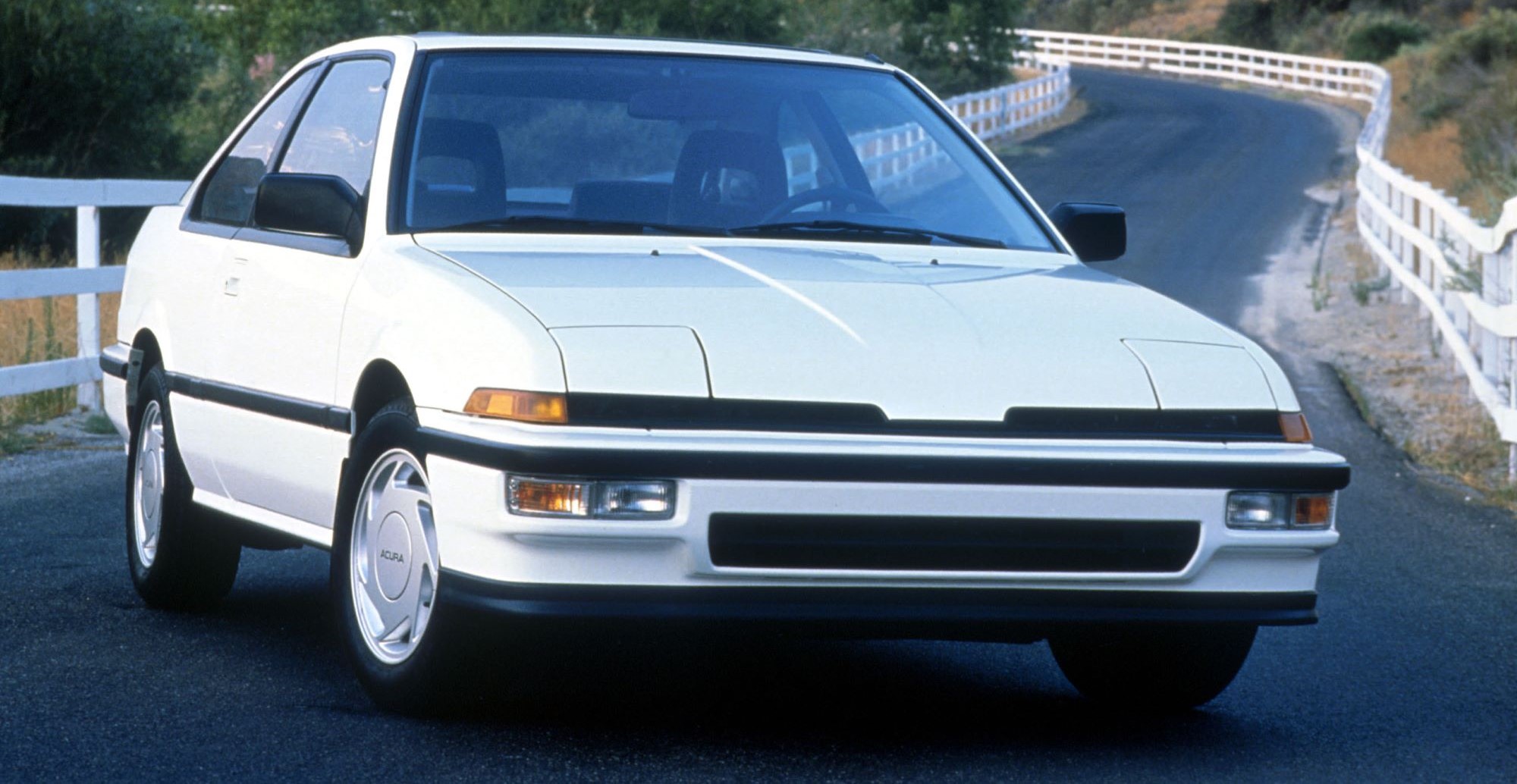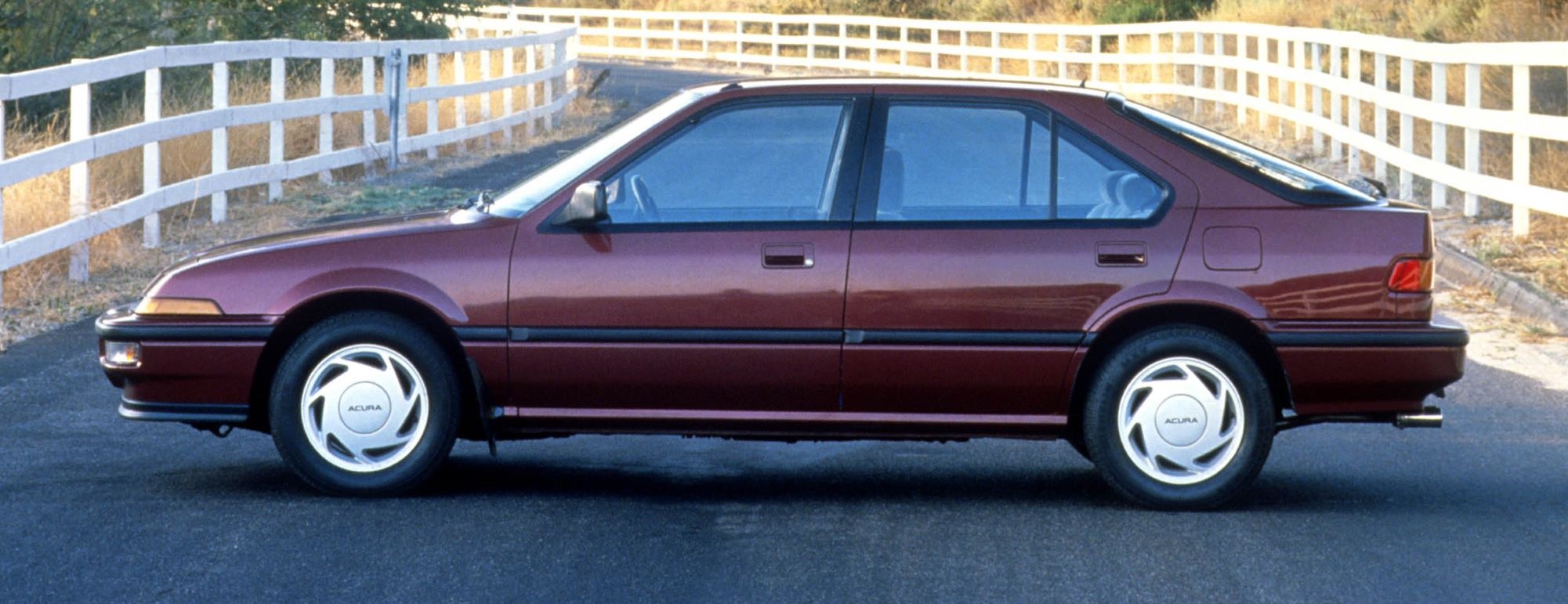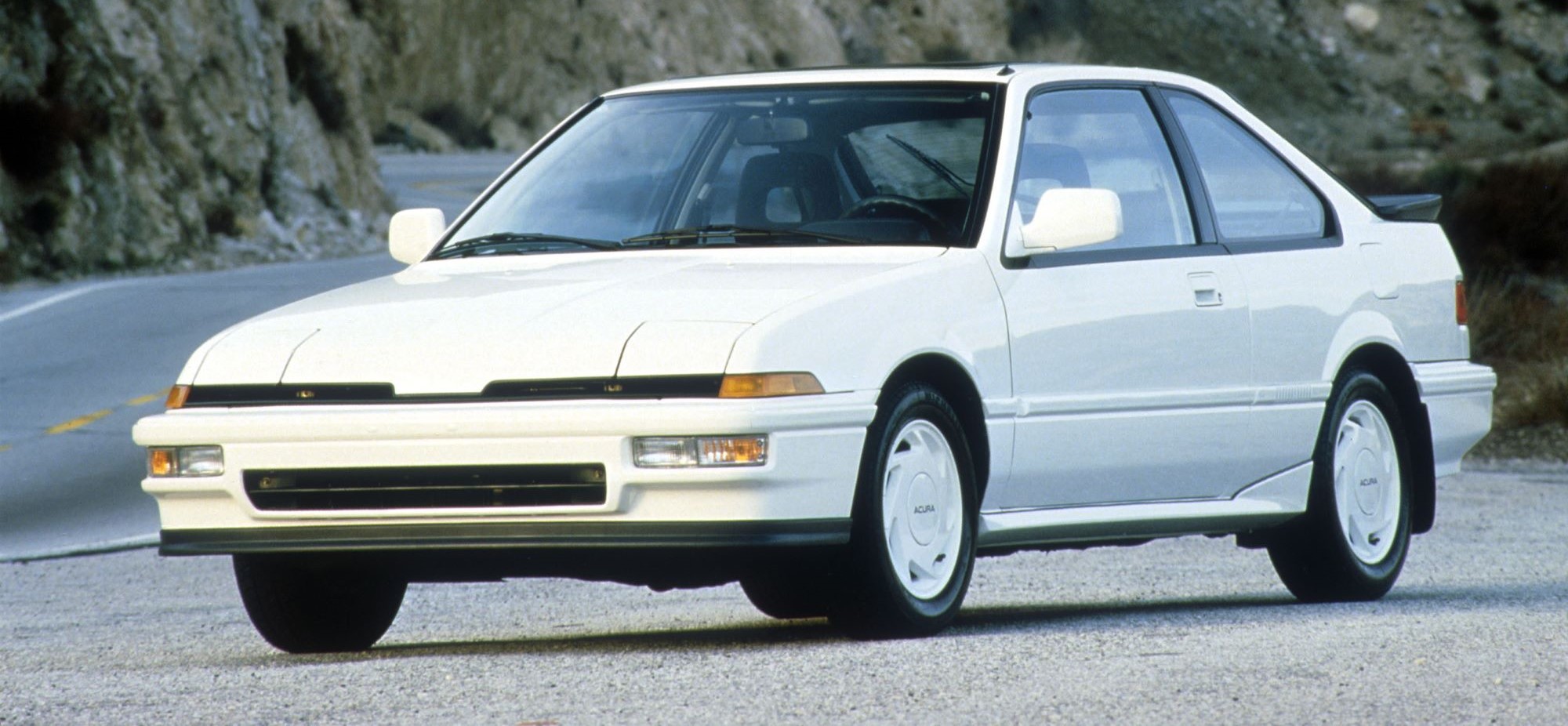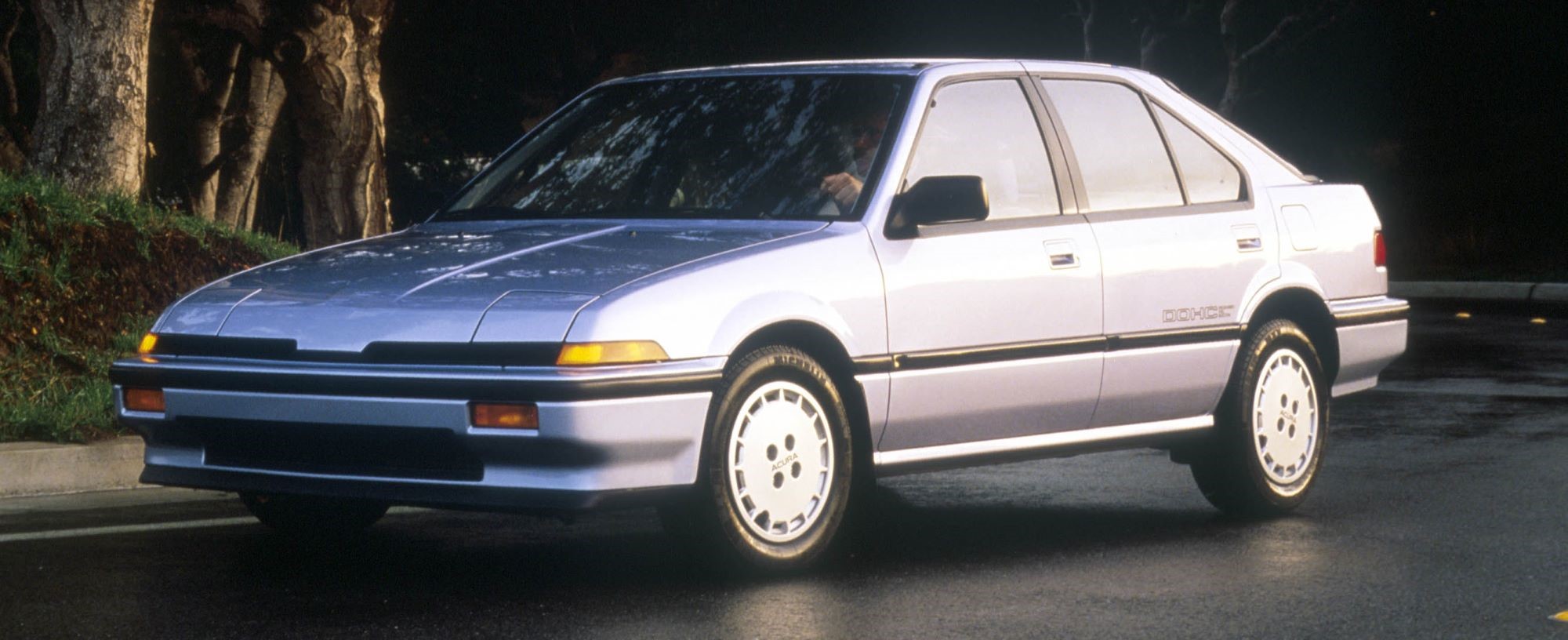
1989 Acura Integra Sports Sedans
The 1989 Acura Integra sports sedans offer the performance, handling, style and value that has won outstanding consumer acceptance since introduction. For 1989, the Integra line-up includes 3-door and 5 door hatchback models in choice of fully-equipped RS or top-of-the-line LS trim levels.
“The Acura Integra has been very successful in the marketplace because it fits the needs and active lifestyle of today’s sports sedan buyers,” said Ed Taylor, vice president of the Acura Automobile Division. “These buyers want performance, comfort, utility and reliability, and that’s what the Integra delivers.”
The distinctive, wedge-shaped Integra sports sedan was designed using advanced Computer Aided Design techniques and extensive wind tunnel testing to achieve a low coefficient of drag of 0.34. Contributing to this aerodynamic efficiency are such design features as integrated front spoiler/air dam, retractable halogen headlights, near-flush glass and door handles and smoothly sloped windshield and rear window.
Use of narrow roof pillars and large glass areas result in 310 degrees of driver visibility, while unit-body construction and utilization of compact mechanical components allows efficient use of interior space and an extremely rigid body structure.
The convenient hatchback design, with its large, easy-opening hatch and standard cargo cover adds versatility for carrying bulky cargo.
Under the smooth exterior and comfortable interior is a technically advanced, competition inspired drivetrain that provides spirited performance and responsive handling.
The Integra 16-valve DOHC1.6-liter four cylinder engine reflects technology developed by Honda Research & Development Co., Ltd. engineers through Honda Motor Co.’s long-standing Formula 1 racing association — including lightweight aluminum alloy construction, four-valves-per-cylinder design and programmed fuel injection. The Integra powerplant develops 118 horsepower (at 6500 rpm) and 103 lbs.-ft. of torque (at 5500 rpm).
Systems such as tuned intake and exhaust manifolds, computer-controlled fuel injection, pent-roof combustion chamber with centrally-located spark plug, and fully-transistorized ignition combine to provide sporty performance across the full rpm range.
A choice of transmissions is available — a standard short-throw 5-speed manual or 4-speed automatic with lockup torque converter.
The Integra suspension delivers balanced handling and a comfortable ride through the use of independent strut/torsion bar in front and trailing link beam type rear suspension with progressively-wound coil springs and gas-pressurized shocks in the rear. Stabilizer bars are utilized front and rear to minimize body roll during cornering.
An equal-length halfshaft design front-wheel drive system virtually eliminates traditional front-wheel drive torque steer. providing smooth acceleration. Standard power-assisted rack-and-pinion steering gives positive road feel and control while maintaining low steering effort at lower speeds.
Both RS and LS trim levels offer a range of standard comfort and convenience features. The Integra RS includes items such as side window defoggers, remote hatch and fuel-filler door releases, dual remote operated door mirrors, rear window wiper/washer and defroster, front door storage pockets, cargo area cover, digital quartz clock and two-speed wipers with intermittent action.
Standard power-assisted 4-wheel disc brakes with ventilated front rotors provide consistent. fade resistant stopping. Performance-oriented steel belted radial tires — 195/60 R14 with full wheel covers for the RS. Michelin MXV 195/60 R14 and alloy wheels for the LS — enhance handling and traction.
Inside the stylish Integra body is an ergonomically engineered interior designed around the driver. The instrument panel is dominated by large, white-on-black analog gauges. All frequently used switches and controls are conveniently placed within easy reach of the steering wheel. An adjustable steering column is standard on all models.
The Integra front bucket seats are designed to provide firm support, with thigh and torso bolsters helping hold the driver in place. The large split, fold-down rear seat offers added versatility for cargo carrying. Durable Moquette/tricot fabric (RS) and Moquette (LS) upholstery and cut-pile carpeting add richness and luxury.
All models feature standard three-point front and rear outboard seat belts, with adjustable front seat belt anchors and childproof rear door locks on all Integra 5-door models.
The Integra LS adds an AM/FMstereo sound system with cassette and four speakers, cruise control and stylish alloy wheels with Michelin MXV tires. The 3-door LS includes a standard power-operated sunroof with sliding shade, while the 5-door LS includes power windows and door locks.
The Acura Integra continues to win recognition. being named one of CAR AND DRIVER magazine’s 1988 “10 Best Cars.” And. the Integra was the top ranked sports sedan in the 1988 J.D. Power Customer Satisfaction Index (CSI), tying with the Acura Legend and Mercedes 300/260 for the top score out of all models surveyed.
Integra continues to be a dominant force in International Motor Sports Association (IMSA)International Sedan series competition. The Comptech Racing Integras of Parker Johnstone and Doug Peterson helped Acura win the 1987 Manufacturer’s Championship and have won numerous races in the 1988 season. including West Palm Beach. Mid-Ohio. Watkins Glen and Road America.
The Acura Division was also ranked the numberone nameplate in the overall 1988 J.D. Power CSI standings. the second year in a row at the top in the annual survey for product quality and dealer service.
“The Acura Integra is an exciting performer — on the race track. in the showroom and in competitive product surveys.” said Taylor. “We expect 1989 to be another winning year for the Integra line of advanced sports sedans.”
All Acura automobiles are covered by a 3-year. 36.000-mile limited warranty.

1988 Acura Integra Sports Sedans
ENHANCED PERFORMANCE. CONTINUED REFINEMENT
The Acura Integra line of sports sedans has been refined for 1988 and continues to provide spirited performance and exceptional value. Horsepower has been increased by five to 118hp., while interior refinements add to driver and passenger comfort. Available as a 3-door or 5-door hatchback in the fully-equipped RS or top of the line LS versions, all Integra models feature a technologically advanced 16-valve, DOHC fuel-injected 1.6-liter engine, sports-tuned suspension and 4-wheel disc brakes.
“The Acura Integra sports sedans have been an immediate success in the marketplace,” said Ed Taylor, vice president of the Acura Automobile Division. “With the interior and exterior refinements and additional horsepower for 1988, we expect the Integra to become even more popular with the knowledgeable, driving enthusiast buyers.”
The aerodynamically efficient Integra body was designed using advanced Computer Aided Design techniques and extensive wind tunnel testing. Retractable halogen headlights, nearly-flush glass and flush door handles and a smoothly sloped rear window contribute to a coefficient of drag of just 0.34. For 1988, the integrated front spoiler/air dam has been redesigned.
Unit-body construction and utilization of compact mechanical components — including engine and suspension –allows efficient utilization of interior space and an extremely tight body/chassis platform.
The race-bred Acura Integra engine reflects the advanced technology developed by Honda Research & Development Co., Ltd. engineers through the company’s long-standing Formula 1 Grand Prix association. For 1988, the lightweight aluminum alloy (with cast iron cylinder liners) engine produces 118 horsepower and 103 lbs-ft of torque. With a sportier feel for a broad range of driving conditions, the powerplant offers an outstanding blend of power and fuel efficiency.
The engine incorporates sophisticated design elements, including four valves per cylinder and centrally-located spark plug for more efficient combustion, tuned intake and exhaust manifolds for strong mid-range torque, and an advanced computer-controlled Programmed Fuel Injection system which maintains the most efficient air/fuel mixture under all driving conditions. Mated to the engine is a choice of transmissions: a standard short-throw 5-speed or optional 4-speed automatic with lockup torque converter.
The Integra suspension provides a balance of agile handling and comfortable ride. The front suspension utilizes an independent strut/torsion bar design. In the rear, progressively-wound coil springs and gas-pressurized shocks provide a firm, comfortable ride regardless of the road. Stabilizer bars are used front and rear to minimize body roll during cornering
Integra’s refined front-wheel drive system virtually eliminates traditional front-wheel drive torque steer through utilization of equal length halfshafts. And, standard power-assisted rack-and-pinion steering provides positive road feel and control while maintaining low steering effort at slower speeds.
Power-assisted 4-wheel disc brakes with ventilated front rotors provide predictable, fade-resistant stopping. Low-profile 190/60 R14 steel-belted radial tires enhance handling and traction.
Excellent interior passenger and cargo room is provided by Integra’s long wheelbase and wide track. The convenient hatchback design, with its large, easy-opening hatch, cargo cover and low liftover height, and the standard split fold-down rear seat backs, add versatility for carrying bulky cargo.
The ergonomically-designed cockpit features a redesigned wraparound instrument panel for 1988. Large, white-on-black analog gauges -including standard tachometer –are precisely positioned for easy readability. All frequently used switches and controls are conveniently placed within easy reach of the steering wheel. An adjustable steering column is standard on all models
Integra’s redesigned body-contoured front bucket seats with thigh and torso bolsters provide firm but comfortable support. See-through headrests are offered on all 3-door models. A new center console on all LS versions offers convenient storage of cassettes and other items, while the rich Moquette upholstery and deep cut-pile carpeting is designed for comfort and durability. New for all 1988 models are 3-point seatbelts on both rear outboard seating positions and adjustable front seat belt anchors on all 5-door models.
Integra automobiles are available in RS and LS trim levels. The fully-equipped RS version includes standard features such as side window defoggers, remote hatch and fuel-filler door releases, dual remote-operated rearview mirrors, rear window wiper/washer and defroster, front door storage pockets, cargo area cover, digital quartz clock, two-speed wipers with intermittent action, and easy-to-reach heating and ventilation controls
In addition to the above features, the 3-door Integra LS includes a new standard power-operated sunroof with shade. Power windows and central door locks are standard on the 5-door LS, while AM/FM stereo sound system with 7-band graphic equalizer, cruise control and stylish alloy wheels with Michelin MXV tires are standard on both 3-door and 5-door LS versions.
Air conditioning and the 4-speed automatic transmission with lockup torque converter are optionally available on all 3-door and 5-door RS and LS models. Six new exterior colors are offered in 1988 — including Almond Creme, Laguna Gold, Cardinal Red, Superior Blue, Montreal Blue and Flint Black — providing Integra buyers with the largest selection ever
All Acura Integra automobiles feature extensive use of anti-corrosion materials, including zinc-coated steel, electrolytic duplex alloy-coated steel, and hot-dipped and iron-zinc alloy steels. All models carry a 3-year, 36,000-mile limited warranty.
In 1987, the Acura Integra was selected as one of CAR AND DRIVER magazine’s “10 Best Cars” and was runner-up to the Acura Legend Coupe in MOTOR TREND’s “Import Car of the Year” competition. And, the Integra dominated the 1987 IMSA (International Motor Sports Association) International Sedan Series competition, with Doug Peterson and Parker Johnstone winning eight of 10 races. Acura won the Manufacturer’s Championship and Johnstone the Driver’s Championship.
“In just a short time the Acura Integra has established a strong reputation as a winning product with the automotive media, with a growing list of satisfied owners, and in racing competition,” said Taylor. “The Integra’s blend of attractive styling, advanced technology and sporty performance is enhanced in 1988.”
| . | Suggested Retail Price | Citv/Hwy |
| INTEGRA 3-DOOR RS | . | . |
| MANUAL |
$10,915 |
26/30 |
| AUTOMATIC |
$11,500 |
26/30 |
| . | . | . |
| INTEGRA 3-DOOR LS | . | . |
| MANUAL |
$12,670 |
26/30 |
| AUTOMATIC |
$13,255 |
26/30 |
| . | . | . |
| INTEGRA 5-DOOR RS | . | . |
| MANUAL |
$11,695 |
26/30 |
| AUTOMATIC |
$12,280 |
26/30 |
| . | . | . |
| INTEGRA 5-DOOR LS | . | . |
| MANUAL |
$13,485 |
26/30 |
| AUTOMATIC |
$14,070 |
26/30 |
| *All information correct as of release date. | ||
| *Based on manufacturer’s suggested retail price. | ||

1987 Acura Integra Performance Oriented Sports Sedans
Reflecting the philosophy and technology behind Honda Motor Co.’s experience in Formula 1 Grand Prix racing, the 1987 Integra automobiles offer spirited driving in the comfortable environment of a sports sedan.
Both the 1987 three-door and five-door models feature a 113 horsepower; 1.6 liter fuel injected dual overhead cam 16-valve engine. A sleek, aerodynamic design, tight-handling suspension and interior comfort delivers performance with enjoyment to match.
Performance begins with the Integra’s powertrain. The fuel-injected 113 horsepower engine has four valves per cylinder with a pent roof combustion chamber and carefully configured intake and exhaust ports. Equal length intake runners assure efficiency and free breathing.
The Integra offers either a 5-speed manual transmission or a 4-speed automatic with lock-up torque converter.
The Integra’s suspension was designed to provide nimble handling without sacrificing ride comfort. A front suspension of torsion bars, independent struts and stabilizer bar minimize body roll in the corners. Progressive-rate springs. coupled with sophisticated gas-pressurized shock absorbers and stabilizer bar in the rear provide a firm, comfortable ride.
Handling is further enhanced by the Integra’s refined front wheel drive system; equal length halfshafts virtually eliminate torque-steer. The Integra’s power-assisted, rack-and-pinion steering system enhances its excellent handling characteristics.
All Integras feature power assisted disc brakes on all four wheels Front discs are ventilated for improved heat dissipation. Low profile 195/60 R14 Michelin MXV tires round out the handling package.
Nearly flush door handles and glass areas, aerodynamically faired sideview mirrors, integrated bumpers, virtually smooth underbody and the elimination of a traditional grille allow the Integra’s horsepower to be used to maximum efficiency. Integra’s semi-notchback silhouette and low hood line both contribute to its efficient aerodynamic configuration. The cars have a 0.34 coefficient of drag and a low lift coefficient of 0.17 to improve stability at highway speeds.
Attention to detail is apparent in the Integra’s interior design. Ergonomics provide the driver with a quiet, relaxed driving experience. Large white on black analog gauges are logically grouped, easy to read and strategically located just a few degrees below the driver’s direct line of vision. All switches and controls are located within easy reach and provide “tactile feedback,” or positive response, when actuated.
Form-fitting seats are incorporated in the front. Contoured rear seats in both the 3- and 5-door models can be folded down individually or together to create additional cargo area. With both seats up, a rigid rear cover conceals personal belongings.
The Integra’s strong, rigid unit-body was designed and tested with the assistance of NASTRAN, a NASA computer program used to test spacecraft design. Anti-corrosion materials are used extensively in Integra manufacturing, including zinc-coated steel, electrolytic duplex alloy-coated steel, hot-dipped and iron-zinc alloy steels. Its underbody is chemically treated to create a protective surface layer that resists corrosion.
Integra automobiles are available in two trim levels, the base line RS and more fully equipped LS models. Standard on the RS models are tinted glass, remote hatch and fuel-filler door releases, rear window wiper and washer, adjustable steering column, power steering and other features. Standard on the LS models are the previously listed items plus alloy wheels, cruise control and a stereo sound system with cassette player and 7 -band graphic equalizer. Power windows and power door locks are standard on the LS 5-door, while a removable sunroof is standard with the LS 3-door.
All Integra models have a 3-year, 36,000 mile limited warranty
| 1987 INTEGRA | . | . |
| RS -3-DOOR MANUAL |
$ 9,859 |
26/30 |
| RS -3-DOOR AUTOMATIC |
$10,389 |
25/31 |
| RS -5-DOOR MANUAL |
$10,559 |
26/30 |
| RS -5-DOOR AUTOMATIC |
$11,089 |
25/31 |
| . | . | . |
| LS -3-DOOR MANUAL |
$11,359 |
26/30 |
| LS -3-DOOR AUTOMATIC |
$11,889 |
25/31 |
| LS -5-DOOR MANUAL |
$12,159 |
26/30 |
| LS -5-DOOR AUTOMATIC |
$12,689 |
25/31 |
| * All information correct as of release date. | ||
1986 Acura Integra
BODY
AERODYNAMICS:
The wedge shape of the Integra is clean and simple with no unnecessary decoration. Integra’s structural integrity was computer analyzed using NASTRAN, a stress testing program developed by NASA, and aerodynamic efficiency was refined through extensive wind tunnel testing.
With its semi-notchback silhouette and low hood line, the Integra yields the following aerodynamic specifications:
- Cd: 0.34
- Cl: 0.24
- Cd x A: 0.62 (6.76)
- Frontal area: 1.85 square meters (19.90 square feet)
Air flow management has been substantially improved by the following:
- Flush surface bodywork, with only 5 mm between the body panels and glass.
- Aerodynamically shaped side mirrors.
- Flush door handles.
- Trimless, flush-mounted side marker lights and taillights.
- Grille opening eliminated; cooling air ducted through integrated front air dam.
This attention to aerodynamic efficiency pays off in reduced wind noise and improved highway fuel efficiency.
INTERIOR:
The driver was an important consideration in the design of the Integra interior. The instrument panel is purposefully simple for minimum distraction and the instruments are large and easy to read. The dashboard is an uncluttered, wraparound expanse. All switches and controls are logically located, well within reach, and easy to use and understand.
SEATS:
Concern for the driver’s comfort and effectiveness was paramount. Consequently, the seats are ergonomically designed for support under all driving conditions. To assure that the seats are firm in the proper places, the cushions are made using a new technique which allows varying degrees of softness to be incorporated in a single foam-casting process. The seat cushion, for instance, is more yielding in the middle and firmer at the sides for better body retention during cornering and reduced fatigue on long trips. The front-seat backs are concave to provide more knee room for back seat passengers. Virtually all interior surfaces, including the headliner, are soft-surfaced. Details, like a foot rest for the driver’s left foot, have not been overlooked
The rear seat backs in both the Integra 3-door and 5-door models are split 50/50. They can be folded down individually or together to create a spacious cargo area. With the seats up, the cargo area is enclosed by a cover which folds up for access from inside the car.
CONVENIENCE:
There are numerous storage areas throughout the interior of the Integra, including: compartments in all the doors; a coin box; a pocket in the center of the front console (LS models) which can be used to hold cassettes; and a storage area in the armrest.
Elastic straps are provided in the corners of the rear cargo area for securing small items, and there’s a molded tray for storing odds-and-ends next to the compact spare tire.
In 3-door LS models, a storage case and tie-down straps are included to secure the removable sunroof in the luggage area.



You must be logged in to post a comment.